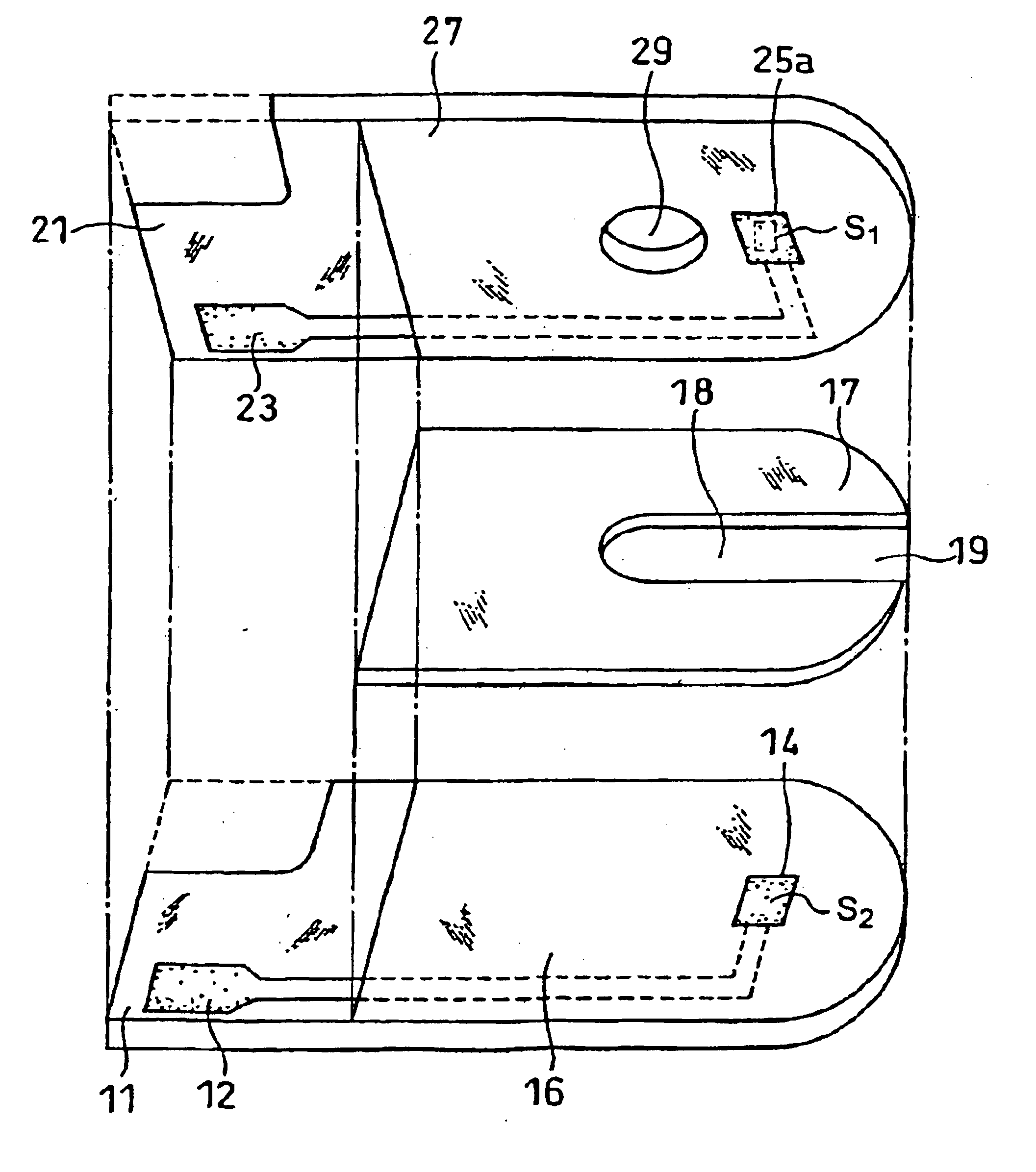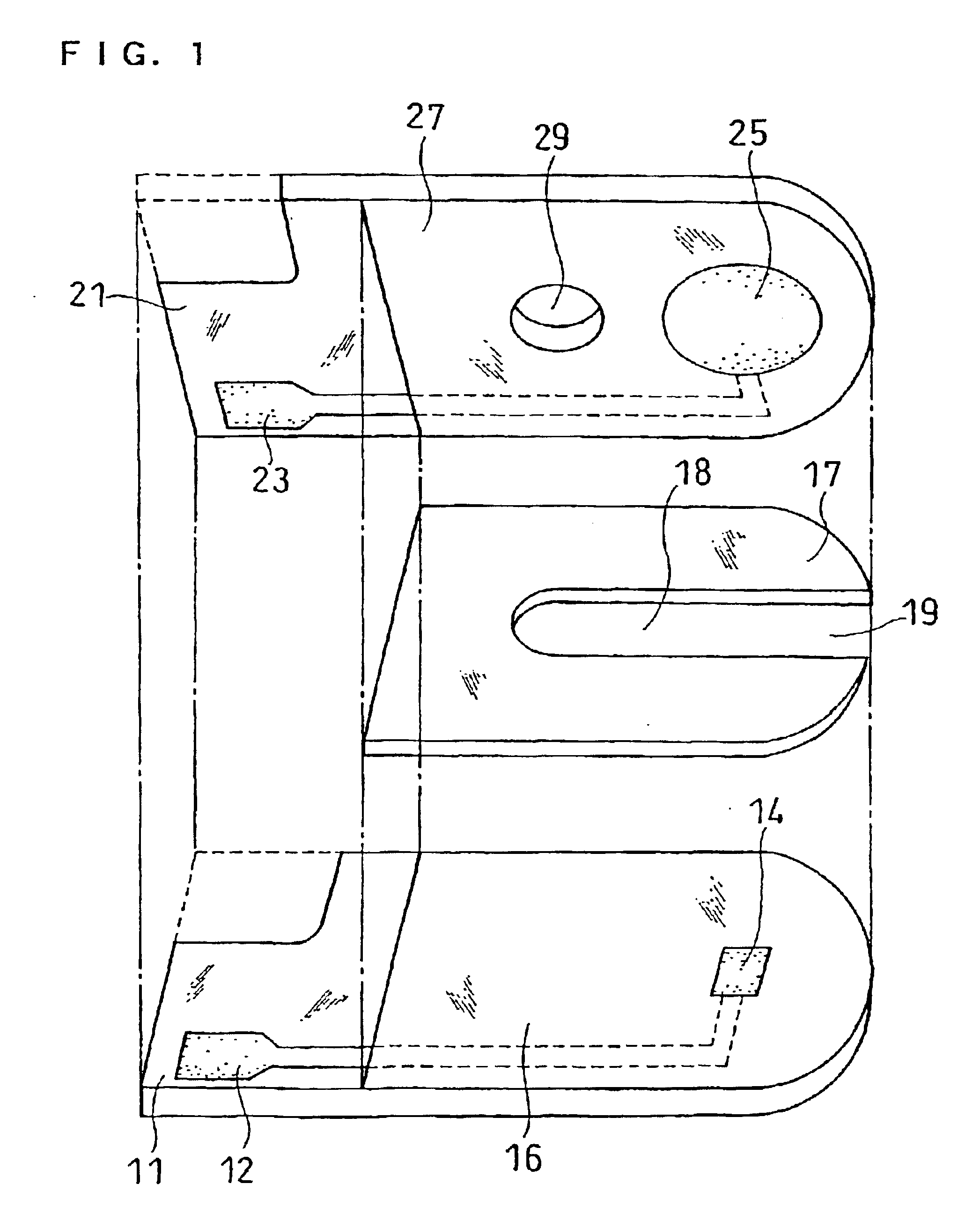Biosensor
a biosensor and sensor technology, applied in the field of biosensors, can solve the problems of poor accuracy, large influence, and poor specificity of sugars, and achieve the effects of improving accuracy and reducing the number of false positives
- Summary
- Abstract
- Description
- Claims
- Application Information
AI Technical Summary
Problems solved by technology
Method used
Image
Examples
embodiment 1
[0043]A glucose sensor will be described as an example of the biosensor.
[0044]With reference to FIG. 1 and FIG. 2, this embodiment will be described. FIG. 1 is an exploded perspective view of a glucose sensor in this embodiment from which the reagent layer and surfactant layer are omitted, and FIG. 2 is a longitudinal cross-sectional view of the glucose sensor.
[0045]Numeral 11 denotes a first electrically insulating base plate made of polyethylene terephthalate. A silver paste is printed on the base plate 11 by screen printing to form a working electrode lead 12 and an electrode base, and a conductive carbon paste containing a resin binder is subsequently printed on the electrode base to form a working electrode 14. The working electrode 14 is in contact with the working electrode lead 12. Further, an insulating paste is printed on the base plate 11 to form an insulating layer 16. The insulating layer 16 covers the outer periphery of the working electrode 14 so as to keep the expose...
embodiment 2
[0051]FIG. 3 is a perspective view of a glucose sensor in this embodiment from which the reagent layer and the surfactant layer are omitted. In this embodiment, a counter electrode 25a is a rectangle similar to that of working electrode 14. The area (S1) of counter electrode 25a is the same as (solid line) or less than (broken line) that of the working electrode (S2). Other than these, this embodiment is the same as Embodiment 1.
embodiment 3
[0052]FIG. 4 is a perspective view of a glucose sensor in this embodiment from which the reagent layer and surfactant layer are omitted, and FIG. 5 is a longitudinal cross-sectional view of the glucose sensor.
[0053]This glucose sensor is produced in the following procedure.
[0054]Palladium is sputtered on an electrically insulating base plate 31 having upright pieces 37, 37 at both sides, to form a working electrode 34 and its lead 32. Next, an insulating member 36 is attached to the base plate 31 to define the working electrode 34 and a terminal portion of the lead 32 to be inserted into a measuring device. Similarly, palladium is sputtered on the inner side of a second electrically insulating base plate 41 to form a counter electrode 45 and its lead 43. Subsequently, an insulating member 47 is attached to the inner side of the base plate 41 to define the counter electrode 45 and a terminal portion of the lead 43 to be inserted into the measuring device.
[0055]Thereafter, the second ...
PUM
| Property | Measurement | Unit |
|---|---|---|
| area | aaaaa | aaaaa |
| area | aaaaa | aaaaa |
| area | aaaaa | aaaaa |
Abstract
Description
Claims
Application Information
 Login to View More
Login to View More - R&D
- Intellectual Property
- Life Sciences
- Materials
- Tech Scout
- Unparalleled Data Quality
- Higher Quality Content
- 60% Fewer Hallucinations
Browse by: Latest US Patents, China's latest patents, Technical Efficacy Thesaurus, Application Domain, Technology Topic, Popular Technical Reports.
© 2025 PatSnap. All rights reserved.Legal|Privacy policy|Modern Slavery Act Transparency Statement|Sitemap|About US| Contact US: help@patsnap.com



